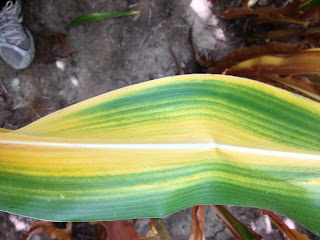The drought stress through the last half of August has accelerated the condition. Where it is severe we can start to find some kernel abortion on the ear tips. The plant has made the decision to allocate resources to the oldest kernels and abort the tip kernels. The yield loss from this is always less than what it appears. In an ideal world we want every kernel. However,the remaining kernels become heavier and will partly make up for the aborted kernels in the tip.
The more moderate firing is often related to N deficiency. This leaf below is showing classic N deficiency symptoms.
It is common to see lower leaves look like this during the grain fill period. As long as it stays below the ear there will be no yield loss. This same plant had a healthy ear leaf and maintains excellent yield potential.
Our Pioneer Area Agronomist, Aric Bos wrote the following about firing. He makes some excellent points, particularly the last paragraph regarding yield and standability. I have reprinted his entire commentary.
For the areas where leaf firing has gone above or is
approaching the ear leaf, or plants show severe stunting, and lighter shades of
green; this has caused concern with growers, and seems to be more excessive in
some areas this year compared to others. In many cases, growers applied N
in such a way to realistically fulfill their yields targets this year, but have
still had excessive firing/N losses.
-
How was the N applied and in what form?
In
many cases this year, side-dressed N fields look strong. Having all N applied
upfront simply puts it more at risk for loss in a year like we had.
The
form of N also played a role. There were growers who side-dressed with Urea,
but didn’t have the moisture to allow it to incorporate into the soil profile,
resulting in N deficiency.
Fertility
programs that credited higher levels of N units to cover crops and manure
didn’t see those units come to fruition in some areas. Mineralization of these
sources of N seemed to be slower this year. In Greg Stewarts pre-side dress
nitrogen sampling survey this year, the level of N available at side-dress time
was lower than expected and is thought to be due to lower levels of
mineralization. (breakdown of organic matter into nitrates).
-
Stresses
Heavy
rains
In
sandy, course-textured soils – the amount of rainfall we had causes large
amounts of N to leach below the root zone and out of reach of plant roots.
In
finer textured soils (clay loams, silt loams) – excessive rainfall caused
saturated soil conditions and denitrification. Denitrification is the process
where soil bacteria breakdown nitrates (the usable form of N) into a non-usable
form for plants, which eventually gets lost to the atmosphere. The key to
denitrification is that the bacteria only breakdown N in anaerobic (saturated)
conditions. Even if there wasn’t necessarily ponding of water in a field,
doesn’t mean those areas weren’t as risk. 5” of rain at a time can make soils
saturated and create anaerobic conditions, even if you don’t see ponding.
Drought
Some
areas became very dry in the last few weeks and some had drought stresses back
around silking. Water is the main carrier of nutrients into a plant. Plants
will sacrifice lower leaves to a greater extent to fill this need. Corn
roots didn’t need to go digging for moisture earlier this spring, and so put
them at a disadvantage when conditions became dry.
Compaction
This
causes root restriction, which doesn’t allow the plants to reach the nutrients,
even if it was available.
-
Yield Losses?
In
cases where whole plant growth was stunted due to excessive moisture,
compaction, drought, etc a yield loss can be expected simply because there is
less plant growth there. 55-60% of a whole plant weight is the grain (harvest
index), and so stunted plants with less above ground growth will yield less.
Yield
losses just from excessive firing are extremely hard to predict. Firing
shows that a plant is prioritizing filling its grain, at the expense of lower
leaves and stalks. One thing to keep in mind would be the late season
standabilty of some of these fields.





No comments:
Post a Comment